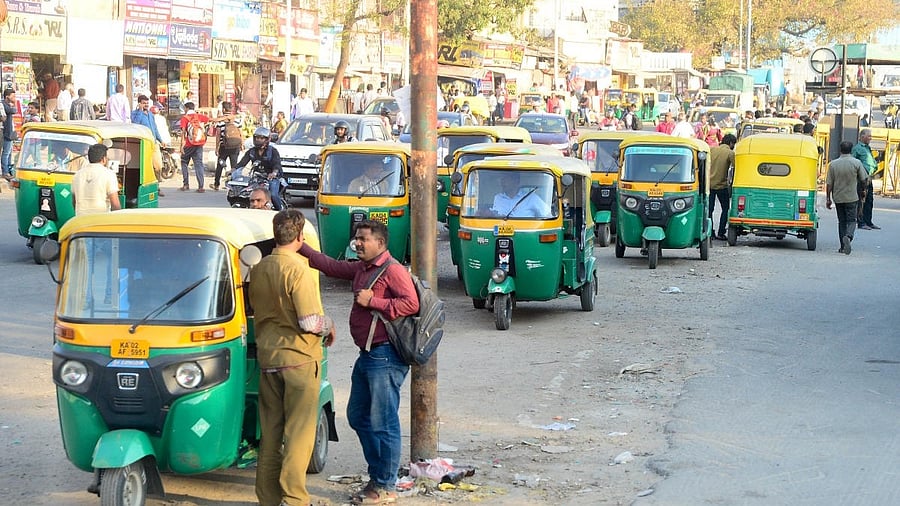
The auto-rickshaw was hailed through a ride-aggregator app.
Credit: DH File Photo
In June 2025, the Karnataka High Court refused to stay a 2024 government order banning bike taxis, citing safety concerns and regulatory gaps, despite operating under the Electric Bike Taxi Scheme, 2021. The decision triggered public uproar due to increased congestion, higher last-mile travel costs, and threatened livelihoods. App-based aggregators Uber and Ola approached the Karnataka High Court, arguing that the ban infringes on their right to trade and undermines last-mile connectivity. Meanwhile, the Goa government chose to continue its suspension of app-based aggregators like Uber and Ola, even after releasing the draft Goa Transport Aggregator Guidelines 2025 for public feedback. Paratransit in India lacks a regulatory framework and faces resistance from traditional operators.
Paratransit refers to a broad spectrum of privately owned vehicles that fill the gaps left by mass public transport. This includes mini-buses serving as metro feeders, auto-rickshaws, shared cabs, bike taxis, and on-demand aggregators. It is essential for last-mile connectivity and often serves as the primary mode of transit in areas where public transport is absent or unreliable. Paratransit functions both as shared or stage-carriage (shared autos or minibuses) and personal or contract-based services (bike taxis or private cab rides).
The primary stakeholders in the paratransit ecosystem—operators, commuters, and regulators—are supported by application developers, local government bodies, and suppliers of vehicles, parts, and fuel. Operators seek regulatory clarity, protection from excessive policing, a level playing field, infrastructure access, and revenue security. Commuters expect services that are safe, reliable, affordable, and responsive to their varying budgets and needs. Regulators must balance these divergent interests to enable sustainable urban mobility.
Each paratransit mode offers a unique trade-off between cost and convenience. Minibuses are affordable but inflexible, while cabs and bike taxis provide faster, personalised, premium travel. These differences allow various paratransit modes to coexist, serving different demographics and geographies. However, traditional unions often view innovation and app-based platforms as threats. Regulators, caught between political pressure and administrative limitations, frequently respond by suspending or restricting services rather than enabling structured competition—leading to fragmented and inefficient last-mile connectivity.
Rapid urbanisation has raised the stakes. Cities like Delhi and Bengaluru have over 150 personal cars and 500 two-wheelers per 1,000 people. Rising private vehicle ownership, traffic congestion, and pollution are symptoms of a larger failure: the lack of integration between public transport and paratransit systems.
Globally, there is a growing adoption of Mobility-as-a-Service (MaaS), which integrates multiple transit modes into a single digital interface for planning, booking, and payment. MaaS prioritises commuter convenience and system efficiency over legacy hierarchies and siloed services. Its success depends on clean technology, open-data systems, and digital payments. In India, the real competitor of any paratransit mode is the privately owned vehicle—not other paratransit services.
India’s legal architecture for paratransit is fragmented and inconsistent. State-level schemes often contradict central legislation. Key regulatory processes—such as fare setting, licensing, and insurance—remain vague. The Motor Vehicles Act does not clearly differentiate between different permit types, leading to arbitrary enforcement and frequent crackdowns on shared mobility services. For example, shared auto-rickshaws are penalised due to the lack of clarity between contract and stage carriage regulations. Karnataka’s Electric Bike Taxi Scheme, 2021, lacked sufficient operational guidance, creating room for judicial intervention. Similarly, Goa’s aggregator guidelines remain unenforced due to the disproportionate political influence of legacy unions.
India needs a regulatory framework for paratransit that is both adaptive and clearly defined. It should specify service categories, promote clean fuel adoption, ensure digital compliance, and facilitate data-sharing between operators and authorities.
Fare regulations should be dynamic, reflecting demand, environmental impact, and service quality. Participatory decision-making --bringing together unions, commuters, application developers, and local authorities--should inform both fare structure and policy revisions. State-level public transport authorities or councils could be established to harmonise policies across modes of mobility, ensuring governance that is both cohesive and relevant.
The Kochi Metro Rail Limited (KMRL) partnered with autorickshaw unions to formalise their role as last-mile service providers. These unions were integrated into the formal economy with benefits like branding, fixed fares, and access to digital platforms. The Kochi1 Smartcard enables seamless digital payments across metro, feeder buses, and auto-rickshaws. This strategy improved service quality and helped build commuter trust. Hyderabad is innovating through electrification and integration. It introduced mini electric feeder buses to connect metro stations with residential colonies and implemented licensing norms for aggregators and bike taxis. Using geo-fencing and designated routes, authorities mitigated resistance from unions and ensured orderly operation. Incentives for EVs were aligned with public policy goals and private sector interests, illustrating how regulatory innovation can align diverse stakeholder priorities. The focus shifted from moving vehicles to moving people, recognising paratransit as central--not peripheral--to urban mobility.
(Kumar is a PhD scholar and Rudrodip is an associate professor at the Energy, Environment and Climate Change Programme at NIAS, Bengaluru)